Crispy and golden on the outside, soft and fluffy on the inside, duck fat potatoes are an essential part of any roast dinner – or a perfect side dish for any meal! Learn how to cook the best roast potatoes with maximum crisp and crunch, every time.
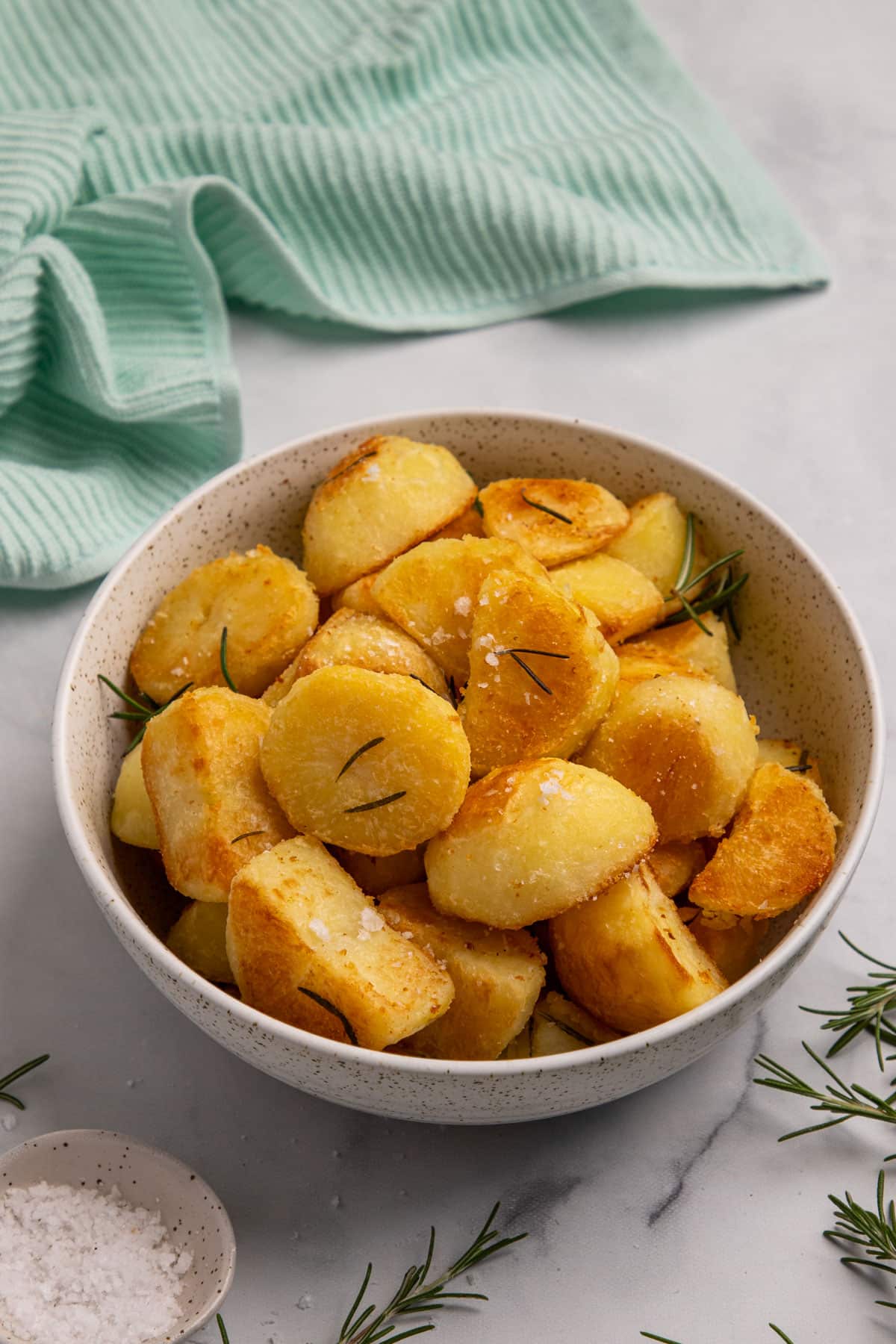
Why you’ll love this recipe
- Easy to make – just 3 ingredients, easy prep and minimal hands-on time.
- The ultimate side dish – crisp, fluffy and seasoned to perfection. They’re the perfect side to an easy weeknight dinner, Sunday roasts or family gatherings.
- Can be prepped ahead and roasted later.
- Extra crispy – thanks to the duck fat and par-boiling method before roasting.
Want another easy side dish for dinner? Try this creamy potato salad or roast pumpkin salad.
Ingredients you will need
** This post contains tips and instructions to achieve the best possible results. This photo is a great guide for when you are in the supermarket, but for full ingredient quantities and methods, please scroll down to the detailed recipe card below!
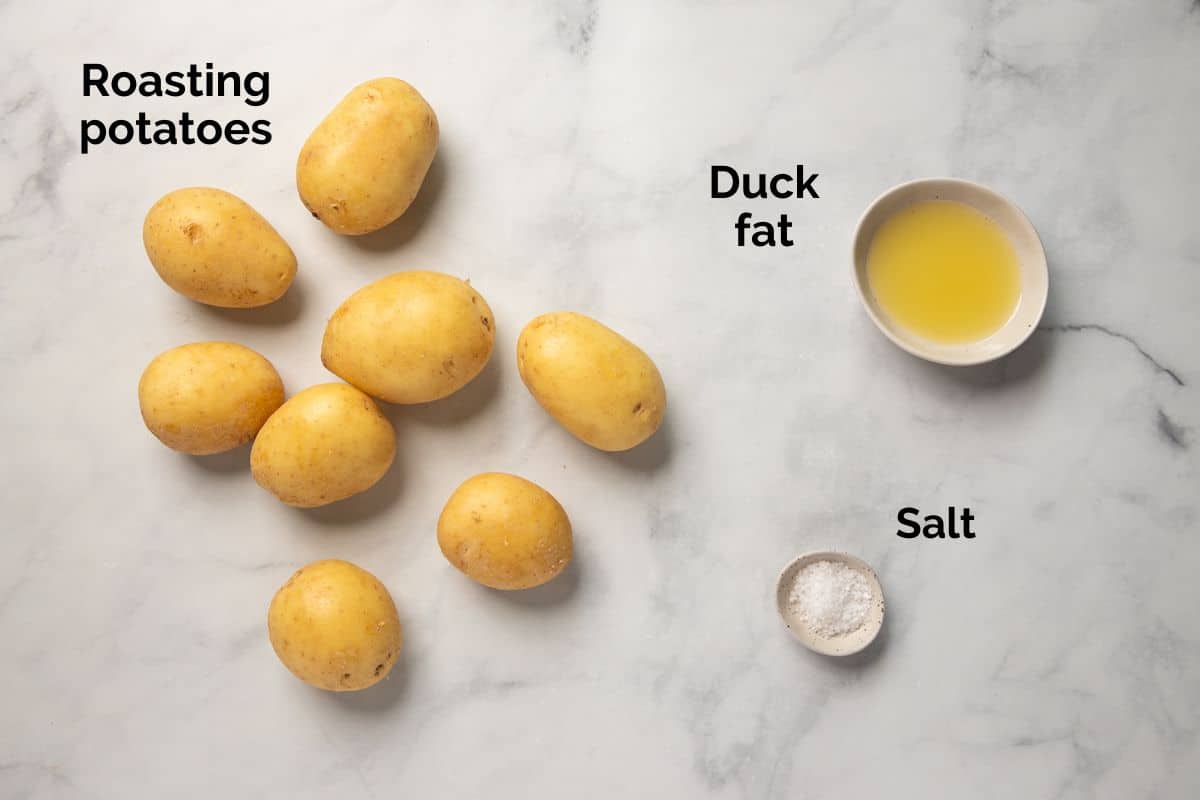
- Duck fat – perfect for roasting potatoes, duck fat has a high smoke point and a deliciously rich (but not overpowering) flavour. And it makes the potatoes so crunchy! Duck fat is sold in jars or tubs and can be found with the other cooking oils in most supermarkets or specialty food stores. Alternatively, a neutral-tasting oil with a high smoke point like vegetable oil can be used.
- Potatoes – different varieties of potatoes vary, encompassing a range of sizes, textures and levels of starchiness. This means that not all varieties of potatoes are suitable for roasting. For a crispy outside and fluffy middle, choose a “floury”, all-purpose or roasting potato variety with moderate amounts of starch and moisture. In Australia, the best potatoes for roasting are Dutch Cream, Desiree, King Edward or Sebago. Elsewhere, Yukon Gold, Russets or Maris Piper are a great option. Peel the potatoes before par-boiling; potato skins won’t crisp as nicely.
- Salt – for perfectly seasoned potatoes, you will need regular table salt in the cooking water (for parboiling) and salt flakes (or table salt) to season after roasting.
- Optional – adding lightly crushed, whole garlic cloves and rosemary sprigs to the roasting pan (or pot when par-boiling) add flavour and aroma to the potatoes. They are optional, but highly recommended!
Step by step instructions
Full ingredient notes and quantities can be found in the detailed recipe card below. But here is a brief overview of what you can expect;
Parboil potatoes;
Add the peeled and chopped potatoes to a pot of cold, salted water and bring to a boil. Boil the potatoes for around 5-7 minutes (from the moment the water starts to boil), or until the potatoes are soft around the edges but still firm in the middle. Don’t overcook the potatoes at the par-boiling stage, or they will become mushy.
Meal prep tip: you can keep the parboiled potatoes in the fridge for 1-2 days before roasting them.
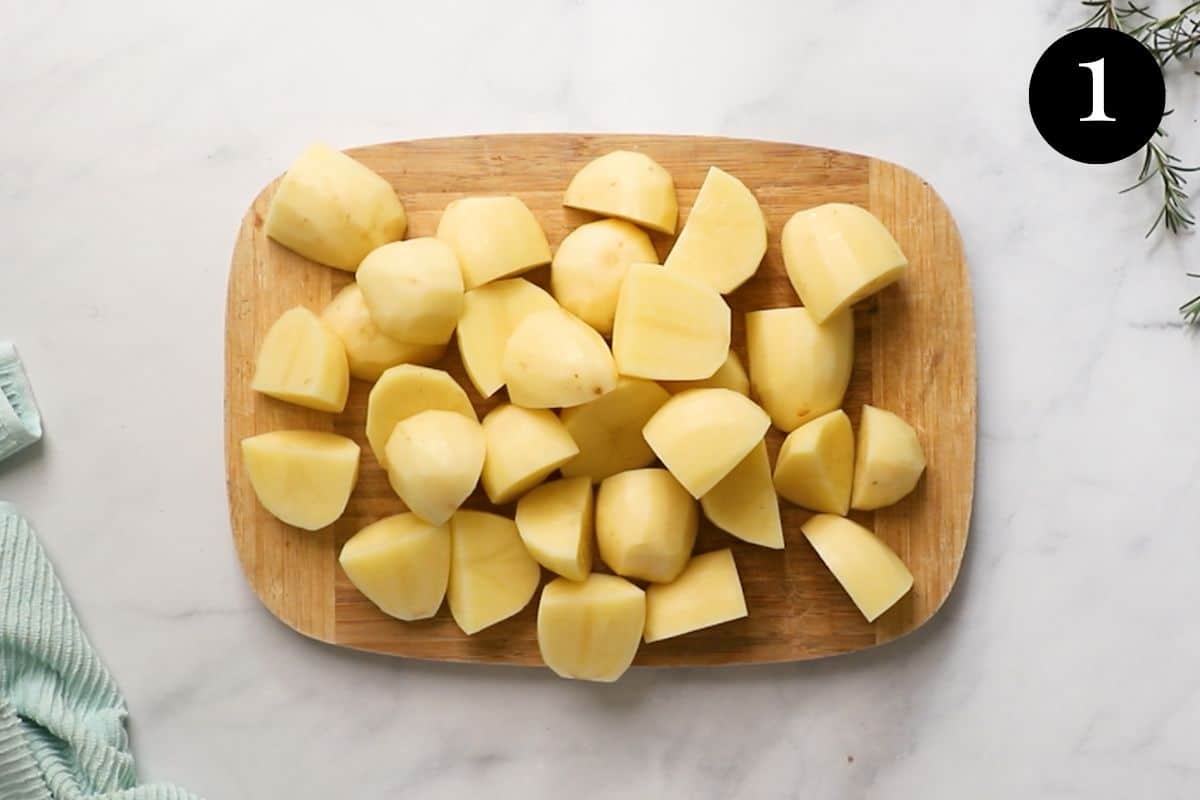
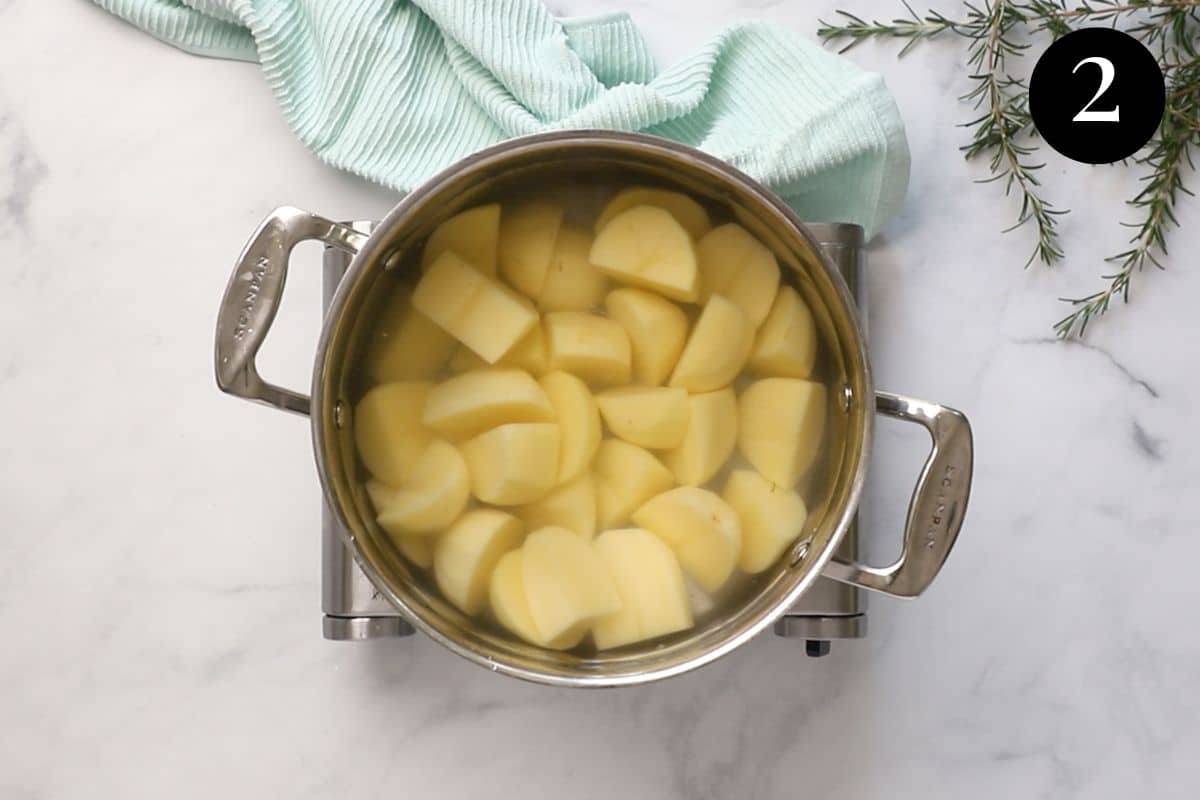
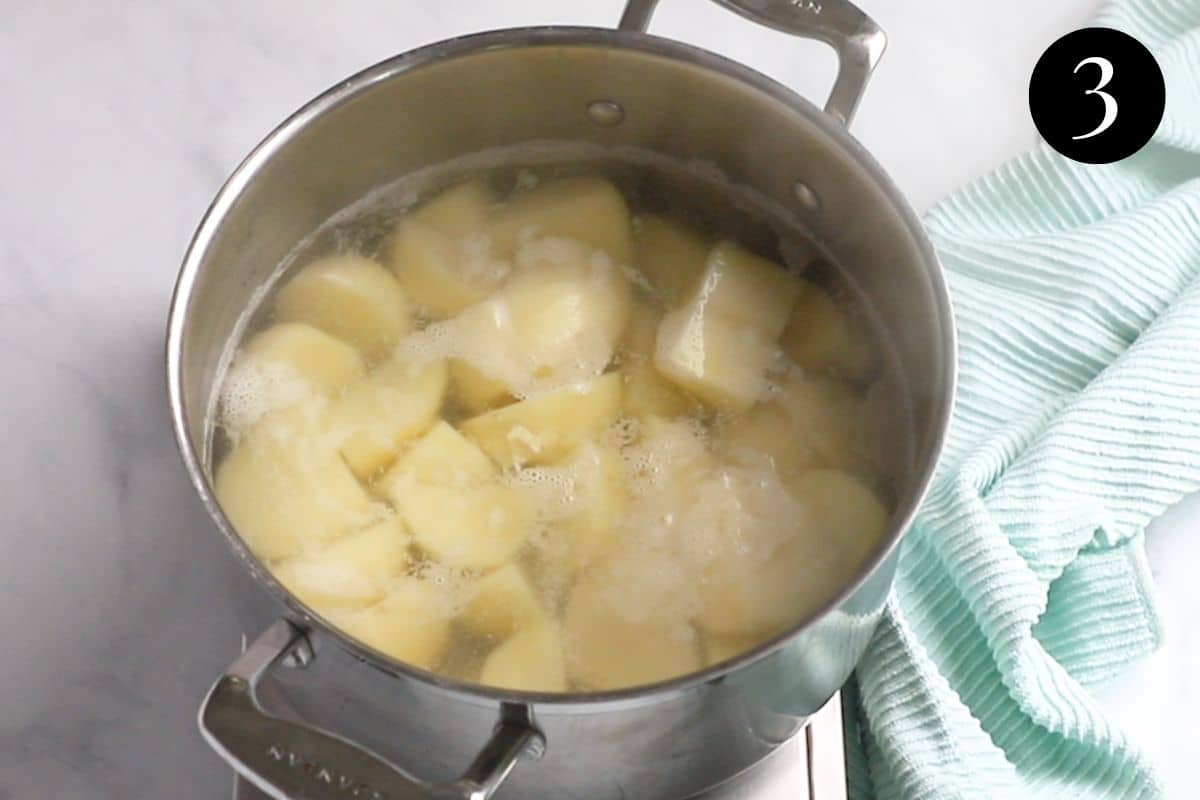
Drain the potatoes and leave them to steam-dry in the hot, dry pot or colander for 1-2 minutes.
Gently shake the colander from side to side, tossing the potatoes around to rough up the edges. Alternatively, you can use a fork to gently rough the edges.
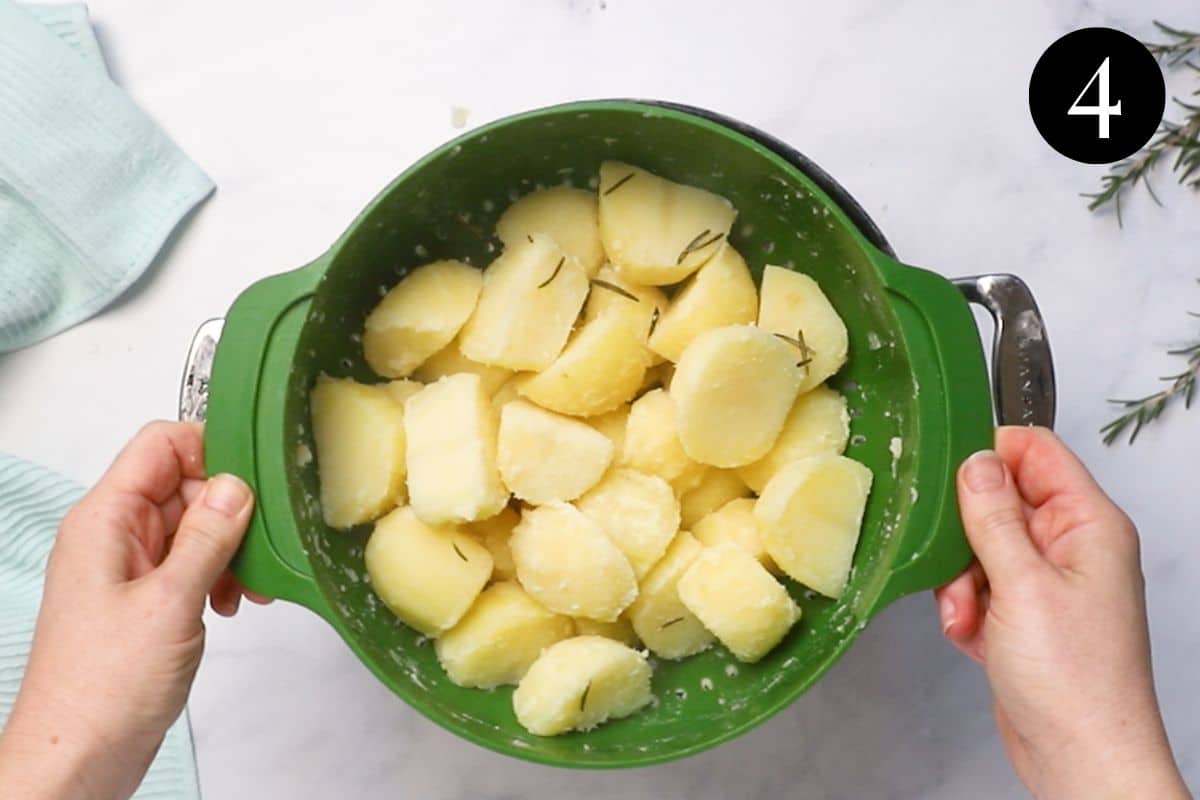
Heat the duck fat;
While the potatoes are par-boiling, spoon the duck fat onto a sturdy roasting tray. Heat the tray of oil in a pre-heated oven at 220 C/ 428 F until smoking hot (around 5 minutes). Remove the tray from the oven.
Carefully and immediately add the drained potatoes onto the oven tray with the hot duck fat. The oil should be so hot that the potatoes sizzle as they hit the pan. Take care with the hot oil and use oven mitts when handling the hot tray.
Use a fork or tongs to gently turn the potatoes, coating them in the oil.
Bake until crisp and golden on the outside and fluffy in the middle, turning every 10-15 minutes until done.
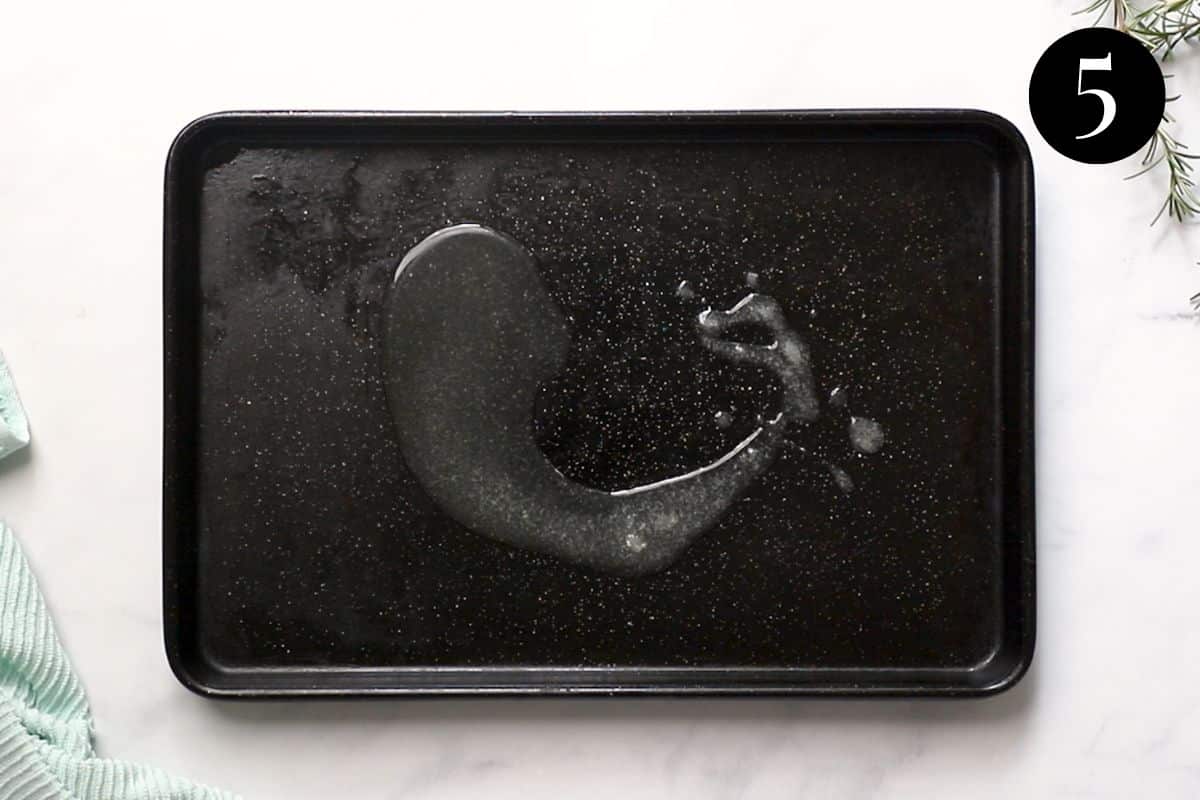
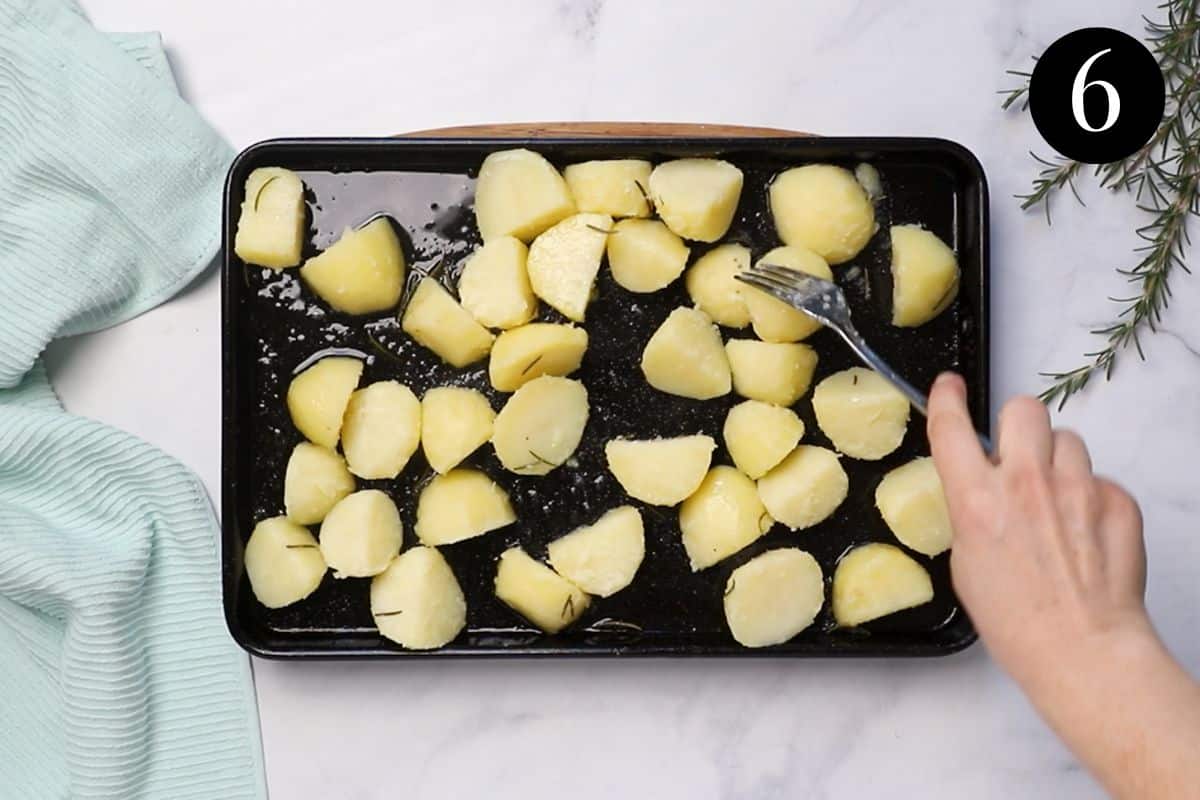
Benefits of par-boiling potatoes
Parboiling potatoes before roasting them results in ultra-crispy, roughed-up edges and fluffy insides that make these the best roast potatoes, ever.
The par-boiling process partly cooks the potatoes, softening them slightly on the outside, while keeping them raw and firm in the middle. The softened exterior of the potatoes can then be “roughed up” by gently shaking them in a colander, creating fluffed edges and craggy bits that will become super crisp when roasted in the duck fat.
Partially cooking the potatoes in water also ensures that they cook all the way through in the oven, resulting in a wonderfully fluffy centre without overcooking the outside.
For best results, add the potatoes to a pot of cold, salted water and bring to a boil. Boil for around 5-7 minutes; only long enough for the outsides to be soft but the insides to remain raw and firm. Allow the potatoes to steam-dry in the hot, dry pot or colander for 1-2 minutes to remove excess moisture. Then, you are ready to roast!
Don’t over-boil the potatoes or they will become too mushy and won’t crisp up as nicely.
Expert tips
- Parboil the potatoes to create ultra-crispy edges. To prep ahead, you can cool the parboiled potatoes and keep them covered in the fridge for 1-2 days before roasting.
- Add some garlic and rosemary to the roasting tray in the last 15 minutes (or into the water when par-boiling) for extra flavour.
- Make sure you season the cooking water with salt, to flavour the potatoes.
- Remove as much moisture as possible from the potatoes before roasting. Drain the parboiled potatoes well and leave them in the colander or hot (dry) pot for 1-2 minutes to steam-dry before roughing up the edges.
- Don’t overcrowd them – use a large enough roasting tray to spread the potatoes into a single layer, with space in between each potato. If the potatoes are crowded together, they will steam instead of roast and won’t become crispy. They should sizzle when hitting the tray.
- Try to cut the potatoes uniformly, so that they finish cooking at the same time. Don’t make them too small, or the insides won’t be as fluffy.
- Make sure the oven is fully heated and the duck fat smoking hot before adding the potatoes to the roasting tray. Otherwise, the potatoes will act like sponges and soak in the fat, making them mushy.
- Use a pair of tongs or a large spatula to flip the potatoes every 10-15 minutes while roasting, to ensure they are crisp all over.
- The potatoes are cooked through when they can be pierced with a fork with minimal resistance through the middle.
- To double the recipe – this recipe can be easily doubled to feed a crowd. But use two trays to ensure the potatoes are not crowded together. If you have a smaller oven, the cooking times may increase slightly.
FAQs
Use 2 tablespoons of duck fat for every 750 grams of potatoes. Don’t add more than needed, or it will be harder to achieve crispy potatoes.
Roast potatoes are best served immediately. However, leftovers can be cooled and stored in an airtight container in the fridge for up to 3 days. Reheat in an air fryer or oven at 150 C for 10 minutes, or toss in a frying pan over medium-high heat with a little olive oil, turning, until crisp and steaming hot in the middle.
To prep ahead, you can cool the parboiled potatoes and keep them covered in the fridge for 1-2 days before roasting. When ready to use, simply heat the duck fat in the oven according to the recipe below and continue cooking as normal.
Potatoes can act like sponges; too much fat or oil can make them soggy. If your potatoes are soggy, it is likely that too much oil was used, the oven wasn’t hot enough or the duck fat wasn’t properly heated in the pan when they were added. Make sure your oven is pre-heated to the correct temperature before roasting. Heat the duck fat in the roasting pan until it is smoking hot before add the potatoes immediately. Quickly turn the potatoes to lightly coat them in oil before roasting. And lastly, ensure that the potatoes are dry (no wet/soggy edges) before adding them to the pan.
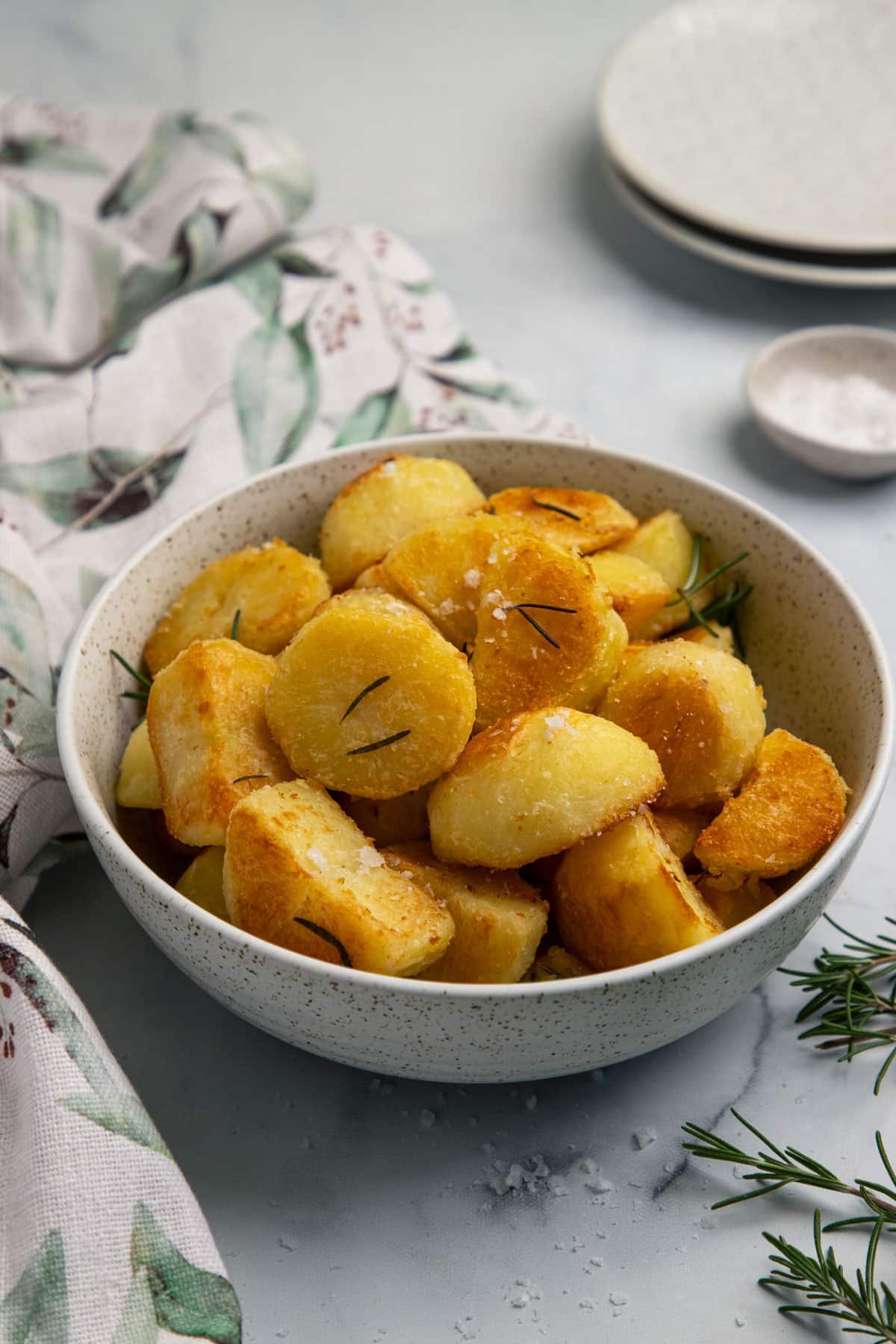
Related recipes
Tried this recipe? Please leave a star ⭐⭐⭐⭐⭐ rating or leave a review below and let you know how you went!
Hungry for more? Subscribe to my newsletter and follow along on Facebook, Instagram and Pinterest for the latest recipes and news.
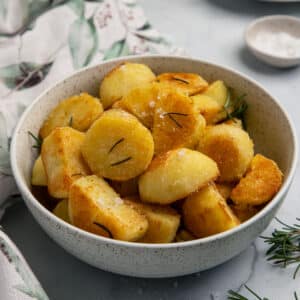
Duck Fat Potatoes
Ingredients
- 1.5 kg potatoes good quality, roasting or 'all-rounder' potatoes like Dutch Cream, Desiree, King Edward, Sebago, Yukon Gold, Russets or Maris Piper.
- 4 tablespoons duck fat 60ml
- salt
Optional
- rosemary to add to the cooking water or roasting pan.
- garlic cloves to add to the cooking water or roasting pan.
Instructions
- Pre-heat oven to 220°C/428 F.
Par-boil the potatoes
- Peel the potatoes and cut them into chunks of 4-5cm width. Keep the sizes as uniform as possible, for even cooking.
- Add the potatoes to a large pot and add enough cold water to cover the potatoes. Generously salt the water and add rosemary and/or garlic (optional). Bring the water to a boil and boil for 5-7 minutes, until the outsides of the potatoes have softened but the insides are still raw and firm.
- Drain the potatoes in a large colander. Dry the hot pot and return the potatoes to steam-dry for 1-2 minutes to remove excess moisture.
- Gently shake the potatoes in the pot (or colander) to rough up the edges of the potatoes for a crispy exterior. This can also be done with a fork, until the edges are "fluffed" up.
Heat the duck fat
- When the potatoes have almost finished par-boiling, spoon the duck fat into a large, heavy based roasting pan. Place the tray into the pre-heated oven to become smoking hot.
Roast
- Using oven mitts, carefully remove the tray containing the smoking hot oil from the oven. Gently place the potatoes onto the roasting tray, using a fork or tongs to turn them, coating them with the duck fat. The fat should sizzle as the potatoes hit the pan. Ensure that the potatoes are arranged in a single layer, with space between.
- Bake for 40-45 minutes, turning the potatoes every 10-15 minutes, until the potatoes are golden and crispy. Season with salt flakes and serve immediately, while hot.
Video
Notes
- Potatoes – different varieties of potatoes vary, encompassing a range of sizes, textures and starchiness. This means that not all varieties of potatoes are suitable for roasting. For a crispy outside and fluffy middle, choose a “floury”, all-purpose potato variety with moderate amounts of starch and moisture. In Australia, Dutch Cream, Desiree, King Edward or Sebago are all perfect for roasting. Elsewhere, Yukon Gold, Russets or Maris Piper are a great option. Peel the potatoes before parboiling; potato skins won’t crisp as nicely.
- Parboil the potatoes to create ultra-crispy potatoes. To prep ahead, you can cool the parboiled potatoes and keep them in the fridge for 1-2 days before roasting.
- Add some garlic and rosemary to the roasting tray (or into the cooking water when par-boiling) for extra flavour.
- Remove as much moisture as possible from the potatoes before roasting. Drain the parboiled potatoes well and leave them in the colander or the hot (dry) cooking pot for 1-2 minutes to dry before roughing up the edges.
- Don’t overcrowd them – use a large enough roasting tray to spread the potatoes into a single layer, with space in between each potato. If the potatoes are crowded together, they will steam instead of roast and won’t become crispy. They should sizzle when hitting the tray.
- Try to cut the potatoes uniformly, so that they finish cooking at the same time. Don’t make them too small, or the insides won’t be as fluffy.
- Make sure the oven is fully heated and the duck fat smoking hot before adding the potatoes to the roasting tray. Otherwise, the potatoes will act like sponges and soak in the fat, making them mushy.
- Use a pair of tongs or a large spatula to flip the potatoes every 10-15 minutes while roasting, to ensure they are crisp all over.
- The potatoes are cooked through when they can be pierced with a fork with minimal resistance through the middle.
- To double the recipe – this recipe can be easily doubled to feed a crowd. But use two trays to ensure the potatoes are not crowded together. If you have a smaller oven, the cooking times may increase slightly.
- Please note that the nutrition information is based on the potatoes being divided into 6 serves. The nutritional information is an estimate only and does not take into account any additional toppings or sides served with the potatoes.
- This recipe is made using Australian metric cups and spoon measurements. Any reference to cups or spoons in this recipe is in Australian metric. Due to cup sizes varying from country to country, I advise adjusting if necessary.


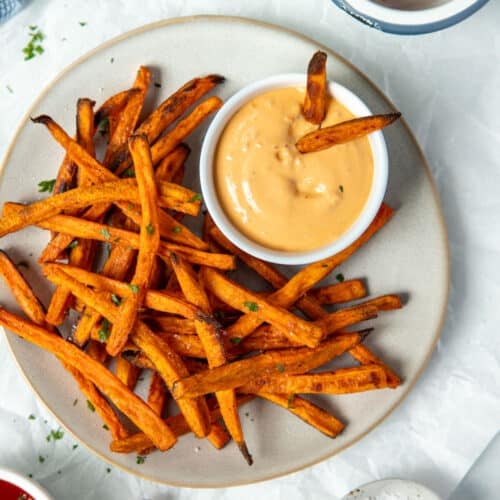
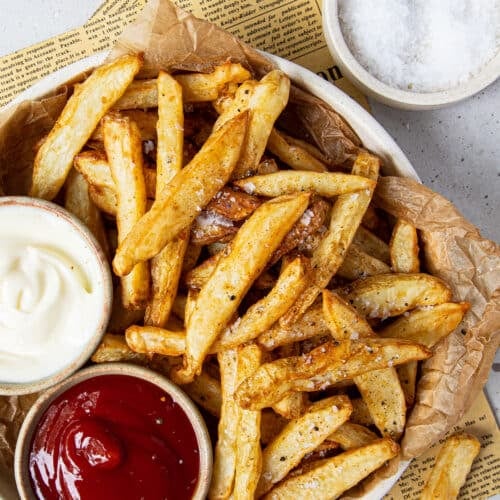
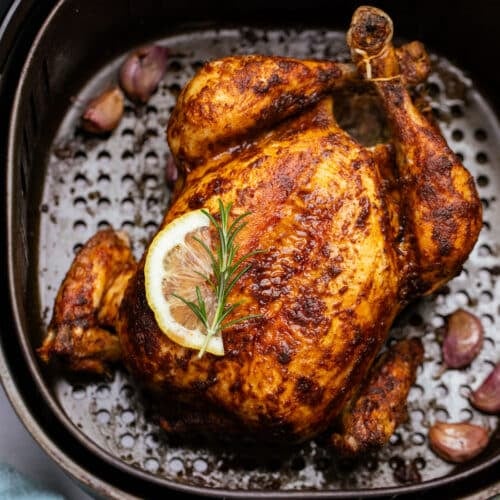
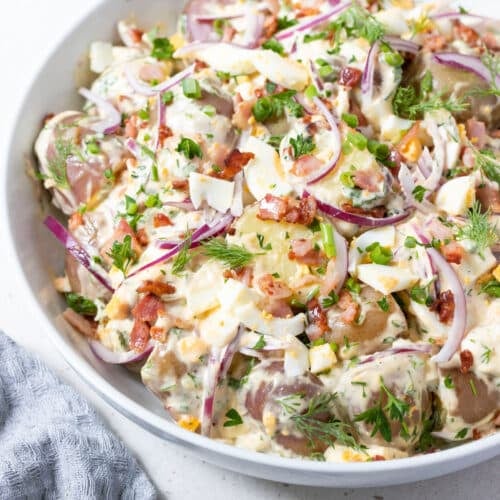
Leave a Reply